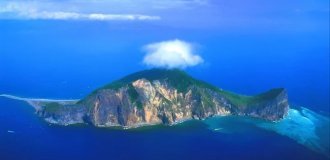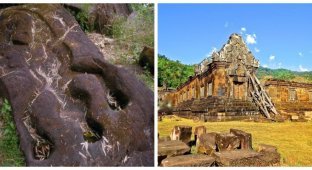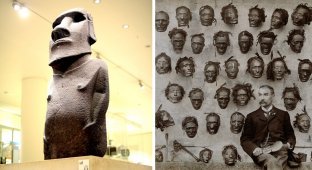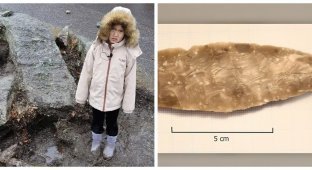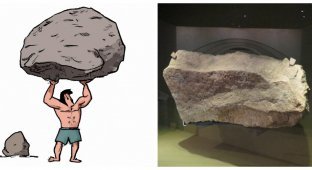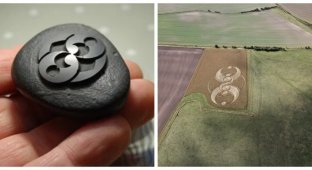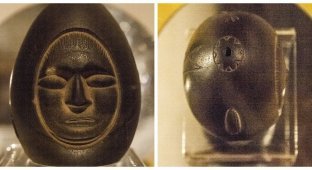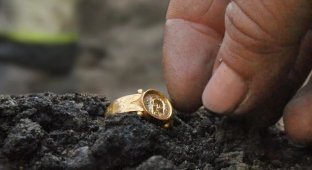The Most Impressive and Significant Archaeological Finds in History (25 photos)
Buried beneath layers of earth and ancient ruins lie relics that have fascinated and baffled historians for centuries. From majestic stone statues on Easter Island to mysterious geoglyphs carved into the Peruvian desert, these unique archaeological discoveries offer a glimpse into the secrets of vanished civilizations. 
Each artifact carefully unearthed from the depths of the earth tells a story of human ingenuity, cultural traditions, and an unquenchable thirst for knowledge. These treasures not only fill gaps in our understanding of history, but also captivate us with their mysterious beauty and significance.
1. The Rosetta Stone 
The Rosetta Stone, on display at the British Museum, London
The Rosetta Stone is a granodiorite stele that contains a decree from 196 BC, issued during the reign of the Ptolemaic dynasty of Egypt under King Ptolemy V Epiphanes. The inscription is written in three different scripts: ancient Egyptian hieroglyphs at the top, Egyptian demotic script in the middle, and ancient Greek at the bottom. This stone played a decisive role in revealing the secrets of Egyptian hieroglyphs.
The artifact was found in July 1799 by French officer Pierre-François Bouchard during Napoleon's Egyptian campaign. It became the first bilingual text from Ancient Egypt in modern history, causing widespread excitement due to the possibility of deciphering hieroglyphic writing.
2. The Dead Sea Scrolls (Qumran Scrolls) 
One of 981 manuscripts
The Dead Sea Scrolls were discovered between 1946 and 1956 in the Qumran Caves near Ein Feshkh. They are a collection of ancient Jewish manuscripts dating back to the Second Temple period and provide insight into the religious and cultural practices of the time.
They span the period from the 3rd century BCE to the 1st century CE. and include some of the earliest known versions of biblical texts, as well as extra-biblical and deuterocanonical writings from the Second Temple period. Most of these manuscripts are housed in the Shrine of the Book, part of the Israel Museum in Jerusalem.
3. Pompeii 
Garden of the Fugitives: plaster casts of the victims; many of the casts are in the Naples Archaeological Museum
Pompeii is an ancient city located in the modern-day municipality of Pompeii, near Naples in the Campania region of Italy. Along with the nearby cities of Herculaneum and Stabiae, Pompeii was buried under 4 to 6 metres of volcanic ash and pumice following the catastrophic eruption of Mount Vesuvius in 79 AD.
Preserved largely under ash, Pompeii offers a unique snapshot of Roman life frozen in time as it was buried, as well as insights into ancient urban planning. At the time of its destruction, it was a wealthy city with a population of between 10,000 and 20,000. The ash also covered organic materials, including wooden objects and human bodies. As they decomposed, they left behind voids that allowed archaeologists to create detailed plaster casts of the city's inhabitants in their final moments.
4. Altamira Cave 
Polychrome cave paintings, Magdalenian culture, 15,000–8000 BC
The Altamira Cave, located near the historic town of Santillana del Mar in Cantabria, Spain, is famous for its prehistoric art. This cave complex contains charcoal drawings and vibrant polychrome paintings of local fauna and human handprints, offering a glimpse into life during the late Paleolithic period, some 36,000 years ago.
The cave was discovered in 1868 by Modesto Cubillas and was further recognized by the explorations of Marcelino Sanz de Sautuola, who helped bring attention to the significance of these ancient works of art.
5. Tutankhamun's Tomb 
Tutankhamun's tomb contained a vast amount of wealth, such as Tutankhamun's mask
The tomb of Tutankhamun, located in the Valley of the Kings, is the final resting place of the pharaoh who reigned from approximately 1332 to 1323 BC during the Eighteenth Dynasty of Egypt. The tomb has four chambers, as well as an entrance staircase and corridor. Unlike other royal tombs of its era, it is relatively modest in size and decoration - it was probably not originally intended for royalty, and was later adapted for Tutankhamun after his early death. Despite the limited space, the tomb contained a huge number of funerary and personal items (coffins, furniture, clothing, and jewelry), all carefully packed.
The tomb was discovered in 1922 by Howard Carter and his team. It attracted widespread attention due to the well-preserved contents and became one of the most famous discoveries in Egyptology.
6. Knossos 
Reconstructed northern entrance to Knossos
Knossos is a significant Bronze Age archaeological site located on the island of Crete. It was one of the main centers of the Minoan civilization and is famous for the Greek myth of Theseus and the Minotaur. Knossos, located near Heraklion, is an important tourist attraction and is often considered the oldest city in Europe. It is best known for the grandiose Palace of Minos, which, like other Minoan palaces, functioned primarily as a religious and administrative center rather than as a royal residence.
7. The Antikythera Mechanism 
The Antikythera Mechanism; the largest gear in the mechanism is visible, measuring about 13 cm in diameter
The Antikythera Mechanism is an ancient Greek orrery (a mechanical model of the solar system) that is considered the oldest known example of an analog computer. The mechanism was designed to predict astronomical positions and eclipses many years in advance, and could also track a four-year cycle of athletic games similar to the ancient Olympic Games. This rare artifact was found in the wreckage of a sunken ship off the coast of the Greek island of Antikythera in 1901.
8. Pilate's Stone 
Inscription mentioning Pontius Pilate; the original stone is now in the Israel Museum, Jerusalem
The Pilate's Stone is a fragment of a limestone block with a partially preserved inscription mentioning Pontius Pilate, who served as prefect of the Roman province of Judea from 26 to 36 CE. The artifact was discovered in Caesarea in 1961 and is of great historical value as it is one of the few authentic Roman inscriptions from the 1st century CE. Pilate's Stone represents the earliest and only modern record of Pilate, who is known primarily from the New Testament and apocryphal writings.
9. Olduvai Gorge 
A close-up of the red sediment monolith
Olduvai Gorge or Olduvai Gorge in Tanzania is one of the most important paleoanthropological sites in the world; the numerous sites discovered in the gorge have proven invaluable in providing insight into early human evolution. The site is significant because it demonstrates the increasing complexity of early hominin development and social structure, primarily through the production and use of stone tools.
Evidence of hunting and gathering can be seen before the advent of tools, as demonstrated by the presence of gnawing marks that precede cut marks, and the proportion of meat and plant foods in the early hominin diet. The presence of tools and animal remains in a centralized location suggests the development of social interaction and communal activities.
10. Hagar Qim 
The facade of the main temple of Hagar Qim, before the construction of a protective shelter in 2009
Hajar Qim is a megalithic temple complex located on the Mediterranean island of Malta and dating back to the Ggantija phase (3600-3200 BC). The megalithic temples of Malta are among the oldest religious sites in the world, and the World Heritage Committee has called them unique architectural masterpieces.
11. Terracotta Army 
Terracotta Army Museum Display
The Terracotta Army is a collection of terracotta sculptures depicting the troops of Qin Shi Huang, the first emperor of China. It is a form of funerary art, buried with the emperor between 210 and 209 BCE to protect him in the afterlife.
The figures, dating to around the late 200s BCE, were discovered in 1974 by farmers in Lintong County, near Xi'an, Shaanxi, China. In 2007, the three pits containing the Terracotta Army were estimated to have contained more than 8,000 soldiers, 130 chariots with 520 horses, and 150 cavalry horses.
12. Tomb of Philip II of Macedon 
During excavations at Vergina in northern Greece in the late 1970s CE, A cluster of tombs believed to be the burial place of Philip II (359–336 BCE), father of Alexander the Great (336–323 BCE), was discovered in the 1st century BCE. Weapons, armor, and gold and silver artifacts lay alongside precious ossuaries containing cremated bones in these unique tombs near the necropolis of Aegae, the ancient capital of Macedonia.
13. The Staffordshire Hoard 
A selection of striking exhibits from the Staffordshire Hoard
The Staffordshire Hoard is the largest collection of Anglo-Saxon gold and silver objects ever found. It includes almost 4,600 objects and metal fragments weighing a total of 5.1 kg of gold, 1.4 kg of silver, and about 3,500 pieces of cloisonné garnet jewellery.
The hoard is believed to have been buried between 650 and 675 AD and contains artefacts probably made in the 6th and 7th centuries. It was discovered in 2009 in a field near Hammerwich, near Lichfield, in Staffordshire, England.
14. Baghdad Battery 
The Baghdad Battery is a set of three artefacts: a ceramic pot, a copper tube, and an iron rod, discovered together in 1936 at Hujut Rabu, Iraq, near the ancient city of Ctesiphon, the capital of the Parthian and Sassanid empires. The artefact dates to one of these periods, but its exact origin and purpose remain a mystery.
Wilhelm Koenig, then director of the National Museum of Iraq, suggested that the object may have functioned as a galvanic cell, perhaps used for electroplating or electrotherapy. Another theory is that it may have served as a container for sacred scrolls.
15. Roman Dodecahedrons 
Two dodecahedrons (12 faces) and an icosahedron (20 faces) are on display at the Rheinische Landesmuseum in Bonn, Germany
A Roman dodecahedron, or Gallo-Roman dodecahedron, is a small hollow object made of cast copper alloy that has the shape of a regular dodecahedron with twelve flat pentagonal faces. Each face has a circular hole of varying diameter leading to an internal cavity, and each corner is decorated with a protruding knob. These artifacts date back to the 2nd to 4th centuries CE. BC, although their exact purpose remains unknown. They show little to no wear and are not marked with numbers or letters. Some have been found in coin hoards, suggesting that they were either valuable or used to measure the diameter of coins. Others suggest that they were religious artifacts or used for divination.
16. Costa Rican Stone Spheres 
Stone spheres at Finca 6
The Costa Rican Stone Spheres are a collection of over 300 petrospheres found in the Diquis Delta and Caño Island. Locally known as "bolas de piedra" (stone balls), they are often attributed to the extinct Diquis culture and are sometimes called "Diquis spheres". These sculptures are among the most notable stone works from the Isthmo-Colombian region. They are thought to have lined the approaches to chieftains' houses, although their exact purpose and significance remain unclear.
17. Rapa Nui Statues 
Outer slope of Rano Raraku volcano, Moai quarry with many unfinished statues
Easter Island, a special territory of Chile, is located in the southeastern Pacific Ocean, at the farthest southeastern point of the Polynesian Triangle in Oceania. The island is famous for its nearly 1,000 monumental statues, known as moai, created by the early Rapa Nui people.
Almost half of them survive at Rano Raraku, the main quarry, but many have been moved and placed on stone platforms called ahu along the island's coast. Most of the moai have disproportionately large heads, which make up about three-eighths of the statue's total mass, and, notably, none of them have legs.
18. Piri Reis (Piri Reis) Map 
A surviving fragment of the Piri Reis map
The map, drawn in 1513 by the Ottoman admiral and cartographer Piri Reis, is a world map of which only a fragment survives, now housed in the Topkapi Palace in Istanbul. Rediscovered in 1929, the map attracted worldwide attention because it included a partial copy of the now-lost map of Christopher Columbus.
The map's depiction of South America is detailed for its time. Scholars have suggested that the peculiar placement of the Caribbean may have been influenced by an earlier map that depicted Cuba as part of the Asian mainland and Hispaniola as part of Marco Polo's description of Japan. The southern portion of the map is commonly interpreted as an early version of Terra Australis.
19. Nazca Lines 
An aerial photograph of one of the Nazca Lines taken in July 2015, showing a design known as the "Monkey"
The Nazca Lines are a collection of geoglyphs etched into the floor of the Nazca Desert in southern Peru. Created between 500 BCE and 500 CE, the designs were made by removing pebbles from the surface to reveal the contrasting, lighter ground beneath. Many of the lines run straight across the terrain, while others form intricate images of animals and plants. The total length of the geoglyphs is more than 1,300 kilometers, they cover an area of about 50 square kilometers, and the lines themselves are usually 10 to 15 centimeters deep.
20. The Voynich Manuscript 
Flower illustration on page 32
The Voynich Manuscript is an illustrated codex written in an unknown script that has not yet been deciphered. Carbon dating of the parchment allows us to date its creation to 1404-1438. Its origin, authorship, and purpose remain the subject of controversy.
Theories suggest that it could represent a natural or constructed language, a coded message, or some form of cryptography. Other possibilities include a hoax, a reference book, or a work of speculative fiction such as science fiction or mythopoetry, awaiting the context and translation needed to clarify its meaning. The manuscript is named after Wilfrid Voynich, a Polish bookseller who acquired it in 1912.
21. Göbekli Tepe 
Göbekli Tepe, a Neolithic archaeological site in southeastern Anatolia, Turkey, was inhabited between approximately 9500 and 8000 BCE during the Pre-Pottery Neolithic period. The site is famous for its large circular structures with massive stone pillars, which are among the oldest megaliths in the world.
The pillars are decorated with intricate carvings, including anthropomorphic figures, depictions of clothing, and reliefs of wild animals. These artistic details provide archaeologists with valuable insights into the prehistoric religion and symbolic iconography of the era.
22. Sacsayhuaman 
Sacsayhuaman is a fortress located at an altitude of 3,701 m (12,500 ft) on the northern outskirts of Cusco, Peru, the historic capital of the Inca Empire. This impressive complex was built in the 15th century, mostly during the reign of the Sapa Inca Pachacuti and his successors. The site is famous for its massive walls of dense gray limestone. The walls are constructed of large boulders, intricately cut and fitted together without mortar, demonstrating the exceptional engineering skills of the Inca civilization.
23. The Galilee Boat 
An ancient Galilee boat, housed in the Yigal Alon Museum in Kibbutz Ginosar
The Galilee Boat, also known as the Jesus Boat, is a 1st-century CE fishing vessel discovered in 1986 on the northwestern shore of the Sea of Galilee in Israel. The boat, 8.2 m long, 2.3 m wide and with a preserved height of 1.3 m, was discovered during a drought when the water level in the lake dropped. Despite the historical dating, there is no direct evidence linking the boat to Jesus or his disciples.
24. The Grauballe Man 
On display at the Moesgaard Museum
The Grauballe Man is a body discovered in 1952 in a peat bog near the village of Grauballe in Jutland, Denmark. The find dates back to the late 3rd century BC, during the early Germanic Iron Age. The body is remarkable for being so well preserved, down to the hair and fingernails. He was a man of about 30 years of age, 1 m 75 cm tall. He had been killed by having his throat cut (possibly as a sacrifice) and thrown into the bog. The conditions of the bog allowed him to remain virtually untouched for over two millennia.










